|
Ronnie Cryer’s
puppetry career spanned Britain’s Golden Years of
Variety - from the mid-1950s to the mid-1980s. He
enjoyed the final 10 years of Variety Theatre and the
best years of Clubland, playing all the Number One
venues with such legendary entertainers as Max Miller,
Laurel & Hardy, Jimmy James and Tommy Trinder.
Looking back to the
beginning of his interest in marionettes, Ronnie Cryer
is quick to credit the part played by Pelham Puppets in
his choice of career and readily acknowledges that he
had a lot to thank Bob Pelham for.

A very
young Ronnie Cryer in 1951 with his first Marionettes
Ronnie’s first taste
of showbiz came at the age of 9, when, with his Pelham
Puppets, he won a Talent Competition at the Spa Royal
Hall in Bridlington in front of an audience of 3,000
people.
That was in 1948 and
was quickly followed by numerous Sunday School Concerts,
Masonics and the general round of bookings required to
establish his name and gain experience. At the age of
13, Ronnie made his first TV appearance on a programme
called “All Your Own” - a BBC variety show for young
performers presented by Huw Wheldon. The Producer was
Cliff Michelmore and the Musical Director, Steve Race.
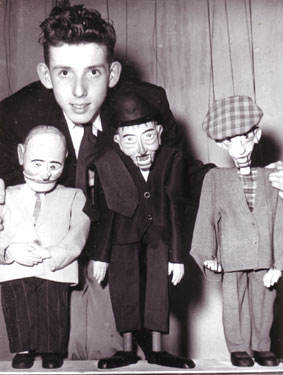
Puppets
from 1957
In those early days,
the puppets were a mixture of the larger-size Pelham
figures and marionettes made by Ronnie’s Father - John Cryer - a professional joiner and cabinet maker, who was
also an accomplished wood carver. The legendary Circus
Clown, Charlie Cairoli was a family friend and John
Cryer’s creative talents were often called upon in
making props for Charlie Cairoli’s Circus Act. John
also carved a very accurate portrait marionette of
Charlie Cairoli pictured below.
|
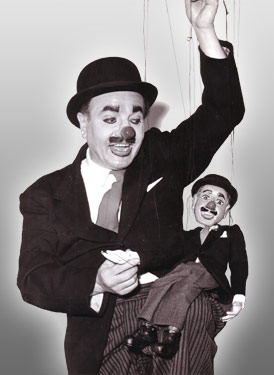
Charlie Cairoli with Portrait Marionette 1959 |

Ronnie's Father - John Cryer in 1958 |
As Ronnie’s career progressed, he
gradually took on the puppet-making duties himself and
at the same time, began to increase the size of the
puppets at the request of the Managements of the larger
venues in which he was now appearing.
|
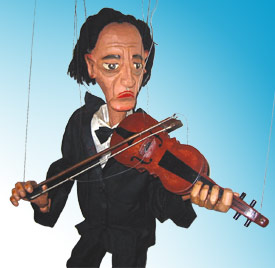
Violin Virtuoso |
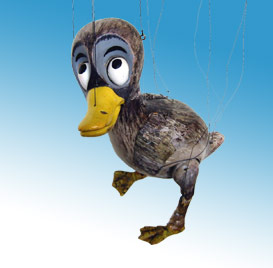
Wudruf the Duck |
Early influences for Ronnie were the
amazing cabaret puppets of Martin Granger and an
Italian Family of puppeteers who toured extensively with
Tommy Trinder – a role which Ronnie took over
himself in later years and notes that Tommy Trinder did
not like to appear with other comedians, but he liked to
be supported by other acts that got laughs and puppets
fitted the bill perfectly.

Eric Bramall was also a source
of inspiration, but this was in the years immediately
before Eric set up the Harlequin Marionette Theatre,
when he was engaged for Summer Seasons in Colwyn Bay’s
Eirias Park and Ronnie Cryer made appearances in Variety
at the Pier Pavilion. Pictured below is the
title page of Whanslaw's book "Animal Puppetry" in
which the Producer of the Pier Pavilion Show has
written: “To Ronald Cryer upon the occasion of his
first engagement in ‘Variety’ at Pier Colwyn Bay August
10th week 1953. Wishing him great success in Life.”
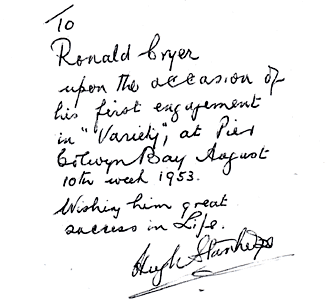
Book
Inscription 1953
He would have little realised at the
time, the role the Pier Pavilion and Colwyn Bay would
come to play in the future of British Puppetry, with
Colwyn Bay becoming home to the Harlequin Marionette
Theatre in 1958 and the Pier Pavilion becoming a
principal venue for the 1963 International Puppet
Festival.
Ronnie’s most popular acts with
audiences, were his caterpillar and a singing camel
which had another little character who popped up out of
the hump to provide a second singing voice. In
terms of manipulation, the routines Ronnie was most
proud of were his sand dancer and pianist characters.
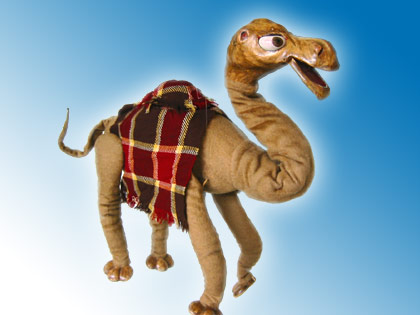
"Speedy
Gonzalez" (with hidden occupant)
In the earlier part of his career,
like most other speciality acts of the time, Ronnie used
the pit orchestra. It was only in the later years that
pop records started to be used and even then, Ronnie
still used a combination of the pit orchestra and
recordings.
Ronnie’s all-time favourite venues
were Leeds Empire (now Harvey Nichols) and
Bradford Alhambra, with his least favourite,
surprisingly, being Leeds City Varieties – the
reason being that for an act relying on a follow-spot,
the City Varieties still used their original limelights
which had a habit of failing right in the middle of
Ronnie’s act, plunging the whole theatre into blackout.
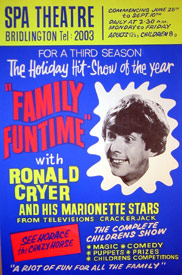
1968-1970 |

Variety 1968 |
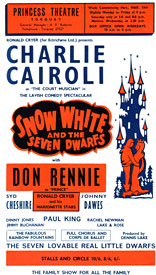
Pantomime 1967 |
It is difficult to imagine today how
popular seaside summer shows once were and the top name
stars who appeared in them. During the heyday of his
theatre appearances, Ronnie remembers a Season on
Blackpool North Pier which opened in May and ran
until November, playing three shows a day to packed
houses. During its run, the Producer of this show would
be devastated if any seats remained empty at any
performance – and such seats would not be empty for want
of patrons, they were simply single seats isolated at
the end of rows by block bookings which the Producer
thought the Box Office Staff should have been able to
allocate better.
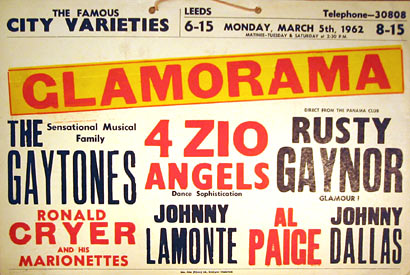
Leeds
City Varieties 1962
Around this time, Ronnie worked with
the Dalibors on the very first Pinky & Perky TV series –
“Pinky & Perky’s Pop Parade” but plentiful stage
work meant he was unavailable for further series.
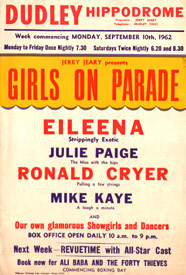
Weekly Revue 1962 |

Summer Season 1961 |
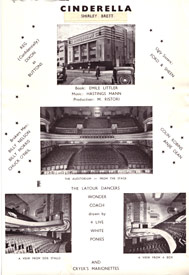
Pantomime 1964 |
When variety re-located to Clubland in
the 1970s, Ronnie moved to the North East, from where he
could work almost non-stop without travelling much
further than 40 miles from home base. The act was again
tremendously popular. So much so, that at one point, he
had to ask his agent for a night off, as he had been
working 7 nights a week, very often at more than one
venue per night for 16 weeks without a break.
Considering the size, weight and number of figures
involved, it is amazing to think that Ronnie undertook
this colossal workload, single-handedly for about 30
years.
By the early 1980s, Ronnie could sense
that Variety was coming to the end of the road. He
could see other entertainers, even some of the greats,
becoming unable to find work and having no other skills
and little or no savings to fall back on. So even
though he had firm offers of panto for the next 3 years,
Ronnie decided it was time to leave puppetry to pursue
other business interests and although he remains a
prominent figure in the Leisure Industry, he never
returned to puppetry.
|
The Ronnie Cryer
Marionettes have now joined the Douglas Hayward
Puppet Collection at the Staffordshire County
Museum, Shugborough Estate, Staffordshire.
The Museum is open to the public from March to
October each year.
|
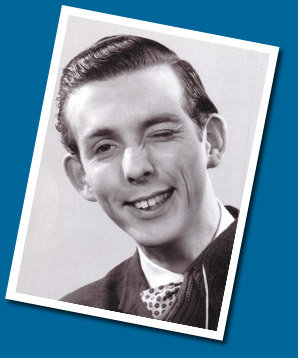 |
|